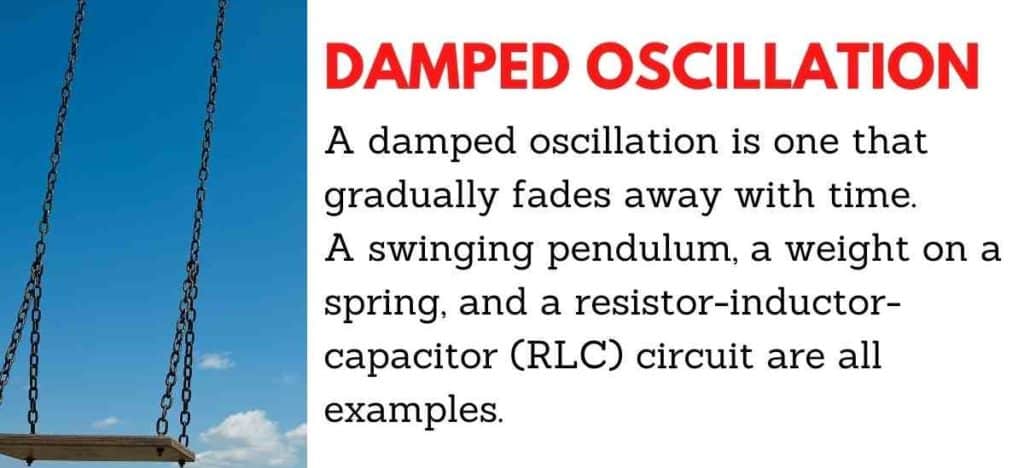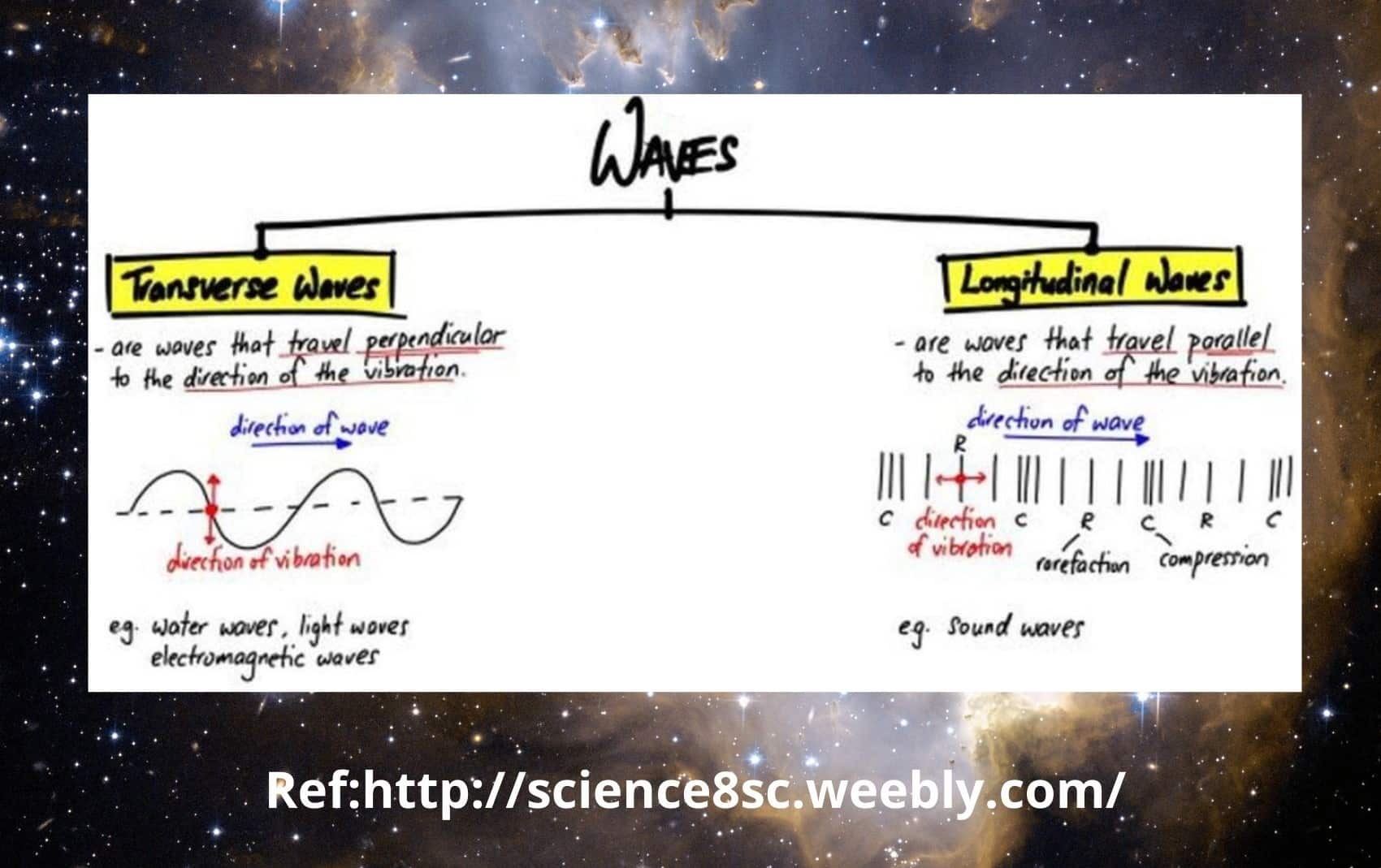A damped oscillation is one that gradually fades away with time. A swinging pendulum, a weight on a spring, and a resistor-inductor-capacitor (RLC) circuit are all examples.
The term “undamped oscillations” refers to oscillations that have not been dampened. Undamped oscillations occur when a simple harmonic oscillator oscillates with a constant amplitude that does not vary with time. S.H.M.

Table of Contents
Daily Life Examples of Damped Oscillations
- Swinging Pendulum: When a pendulum is set in motion, it oscillates back and forth. However, due to friction and air resistance, the pendulum eventually comes to a stop. This is an example of damped oscillation.
- Car Suspension: When a car drives over a bump or pothole, the suspension system undergoes oscillations. However, due to the damping effect of shock absorbers, these oscillations are gradually reduced, resulting in a smoother ride.
- Guitar String: When a guitar string is plucked, it vibrates and produces sound. However, the sound gradually fades away due to the damping effect of the air and the material of the guitar string.
- RLC Circuit: In an electrical circuit containing a resistor, inductor, and capacitor, the current can oscillate back and forth due to the energy stored in the inductor and capacitor. However, due to the resistance of the circuit, these oscillations are gradually reduced over time.
- Bouncing Ball: When a ball is dropped on a surface, it bounces up and down. However, due to the energy loss from each bounce, the height of each subsequent bounce gradually decreases until the ball comes to rest. This is an example of damped oscillation.
Important Points Damped Oscillations
- Damped oscillation is a type of harmonic motion where an oscillating system loses energy over time due to the presence of a damping force.
- The damping force is usually proportional to the velocity of the system and opposes its motion.
- The motion of the system is described by a differential equation of the form mx” + bx’ + kx = 0, where m is the mass of the system, b is the damping coefficient, k is the spring constant, x is the displacement of the system from its equilibrium position, and x’ and x” denote the first and second derivatives of x with respect to time, respectively.
- The solution to this differential equation depends on the value of the damping coefficient b relative to the critical damping coefficient, which is equal to 2√(mk).
- If b < 2√(mk), the system is said to be underdamped, and the motion is characterized by a decaying sinusoidal wave.
- If b = 2√(mk), the system is said to be critically damped, and the motion approaches its equilibrium position as quickly as possible without oscillating.
- If b > 2√(mk), the system is said to be overdamped, and the motion is characterized by a slow exponential decay towards the equilibrium position.
- The frequency of oscillation in a damped system is lower than that of an undamped system, and it decreases over time as the amplitude decreases.
- The rate at which the amplitude decreases is characterized by the damping ratio, which is defined as the ratio of the actual damping coefficient to the critical damping coefficient.
The damping ratio describes how quickly oscillations fade from one bounce to the next. The damping ratio, indicated by, is a system parameter ζ(zeta).
As a result, a damped harmonic oscillator may be classified into three types:
- Overdamped ( ζ> 1): When the system does not oscillate and returns to a stable state.
- When a system is critically damped ( ζ= 1), it returns to a steady state as fast as feasible without fluctuating. Overshoot can also occur as a result of this. However, for the dampening of particular system applications, this is a tolerable phenomenon.
- Underdamped ( ζ=1): When a system oscillates at a frequency that is slightly different from the undamped situation, the amplitude progressively drops to zero.
The Q factor is another parameter to consider in oscillatory systems (quality factor). The Q factor is a dimensionless term in engineering and physics that measures the severity with which a resonator or oscillator is underdamped. In summary, we define it as the ratio of peak energy saved inside an oscillation cycle to the energy lost per cycle radian.
The formula is as follows:
Q = 2π × (energy stored)/(energy lost per cycle)
Because almost all systems in mechanics, physics, and electronics are subject to friction and resistance, it is important that we properly measure the degree of this deterioration. It is critical to the entire design process to have a solid knowledge of how these factors affect functioning.

| Terms | Over Damping | Critical Damping | Under Damping |
| Definition | When the damping force is so strong that the system returns to its equilibrium position very slowly | When the damping force is just enough to bring the system back to its equilibrium position without oscillation | When the damping force is not strong enough to bring the system back to its equilibrium position quickly, and the system undergoes oscillations with decreasing amplitude |
| Amplitude | Decreases faster | Decreases quickly but never reaches zero | Oscillates with decreasing amplitude |
| Time to decay | Shorter | Shortest | Longer |
| Settling time | Longer | Shortest | Longer |
| Resonance | Absent | Absent | Present |
| Practical Examples | Shock absorbers, braking systems, dampers | Electrical circuits, mechanical systems, dashpots | Spring-mass systems, pendulums, poorly damped speakers |
Related Topics
Displacement| Physics
Gravitational Potential Energy (w=mgh)
Linear Motion or Rectilinear Motion
Uniform Circular Motion
Linear Acceleration
Centripetal Acceleration| 9- Easy Examples
Frequently Asked Questions
1. What is strain energy and how is it different from resilience?
Strain energy is elastic, which means that when the stress is removed, the material tends to recover. Resilience is the property of a material that allows it to hold energy without permanent distortion; the energy is released as soon as the load is removed, so the body does not deform permanently.
2. Can displacement be negative?
Displacement can be negative since it is a vector variable that depends on magnitude and direction. The negative sign indicates the direction. Check the full article “can displacement be negative?”.
3. What is a state function?
A state function is a property that depends on the state of a system and is independent of the path taken to get it. Pressure and temperature, for example, are state functions.
4. What is negative work?
Work can be negative if the applied force is in the opposite direction to the moving object’s displacement. Please refer to the full article “Can work be negative?”.
5. What is the damped oscillation definition?
A damped oscillation is defined as an oscillation that gradually fades away with time. A swinging pendulum, a weight on a spring, and a resistor-inductor-capacitor (RLC) circuit are all examples.
6. Crest of a wave?
The portion of the transverse waves above the mean level is known as the crest of a wave. The section of transverse waves below the mean level is referred to as the wave’s trough.
Please refer to the full article “Crest of a wave”.
7. Displacement physics?
Displacement in physics is a vector with a length equal to the shortest distance between the initial and final positions of a moving object.
8. What is gravitational potential energy?
Gravitational potential energy (w) is the energy that an item has as a result of its location in a gravitational field. If the item is pushed straight up at a constant speed, the force (F) necessary to hoist it to the height (h) is equal to its weight (mg).
9. Relativistic kinetic energy?
According to the relativistic kinetic energy equation, when an object’s velocity approaches the speed of light, its energy approaches infinity. As a result, exceeding this speed restriction is impossible.
More Interesting Topics
Stationary Waves| Definition, and Properties
Frequency Simple Definition & Examples
Angular Displacement Formula| Easy Examples
Velocity Time Graph
The Spring Constant & Spring Force Concept
Wavelength| Simple Definition and Examples
- BCl3 Lewis Structure in four simple steps - November 1, 2023
- PH3 Lewis Structure in four simple steps - October 8, 2023
- PF3 Lewis structure in four simple steps - September 24, 2023



